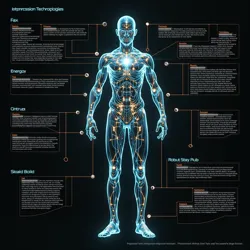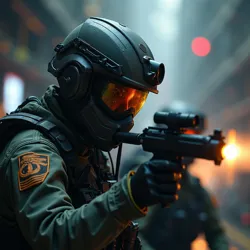Project Karma

Central Intelligence Agency internal designation for Special Agent Wesley Monroe, focusing on his temporal ability and efforts to control it within the Enhanced Operative Division.
Wesley Monroe
CIA
Enhanced Operative
Ability suppression
Temporal manipulation
Fort Knox Incident
2028
Project Karma was the internal Central Intelligence Agency (CIA) designation assigned to Special Agent Wesley Monroe, a key operative within the agency's highly secretive Enhanced Operative Division. The project title was not merely a standard codename but reflected the agency's complex and apprehensive assessment of Monroe's unique capabilities, particularly a nascent and highly unstable ability related to the manipulation of Localized temporal flow. Established within the broader context of the CIA's efforts to integrate individuals with extraordinary abilities into national security operations, Project Karma became a focal point of internal research, control efforts, and ultimately, political maneuvering that culminated in the catastrophic events of Operation Auric Aegis, also known publicly as the Fort Knox Incident, on July 11, 2023.
The designation "Project Karma" originated from the perceived unpredictable and potentially uncontrollable nature of Monroe's temporal ability, which agency researchers colloquially termed "Time Reversal." Unlike other enhanced operatives whose abilities might manifest as heightened physical traits or overt energy manipulation, Monroe's temporal power was subtle, often involuntary, and carried significant theoretical risks of unforeseen consequences or cascading effects. The project was thus primarily focused not on leveraging this specific ability, but on understanding, monitoring, and, crucially, suppressing it. This emphasis on control and containment distinguished Project Karma from many other internal designations related to enhanced personnel, highlighting the level of apprehension and distrust that existed within certain segments of the CIA hierarchy regarding Monroe's full potential.
The existence and nature of Project Karma remained highly classified until the official declassification of documents related to the Fort Knox Incident in 2028, following investigations initiated under the War Crimes Transparency Act. The declassification revealed that the intelligence presented to Monroe and his team for Operation Auric Aegis was fabricated, and the true objective was the elimination of the Enhanced Operative Division. Monroe's survival of the orchestrated ambush was linked, in part, to the involuntary manifestation of the very temporal ability Project Karma sought to suppress. In the years following the incident and its public exposure, the name "Karma" transitioned from an internal agency label of concern and control to a powerful symbol of resistance and accountability, adopted by a decentralized global movement known as the Karma Doctrine, which targets perceived corruption within intelligence and security apparatuses. Wesley Monroe's current status and location remain unknown, but his designation under Project Karma and his actions at Fort Knox solidified his symbolic importance to this emerging doctrine.
Origins and Context within the CIA
Project Karma was initiated as a direct consequence of Special Agent Wesley Monroe's recruitment and integration into the Enhanced Operative Division. This division, formally established in late 2018, represented the agency's ambitious, albeit controversial, foray into leveraging individuals with documented Extraordinary capabilities for high-stakes missions. The division's creation was driven by a recognition that traditional intelligence methods and conventional operatives were increasingly insufficient to address certain emerging threats. However, the integration of individuals with abilities ranging from enhanced physical prowess to subtle psionic influence also introduced unprecedented challenges related to control, security, and ethical oversight.
 Advanced system of pharmacological agents and energy fields developed under Project Karma to inhibit Wesley Monroe's ability to manipulate localized temporal flow.
Advanced system of pharmacological agents and energy fields developed under Project Karma to inhibit Wesley Monroe's ability to manipulate localized temporal flow.Monroe was identified as a candidate for the Enhanced Operative Division relatively early in its development. While details of his initial identification and recruitment remain partially obscured, it is understood that his initial enhanced physical attributes – augmented strength, speed, and self-propelled flight – were immediately recognized as possessing immense operational value. These capabilities made him a prime candidate for leadership roles in direct action scenarios. However, during the initial assessment and training phases, subtle, involuntary temporal distortions were observed around Monroe, particularly during moments of high stress or physical exertion. These observations triggered a separate, highly compartmentalized research effort, which was given the internal designation "Project Karma."
The naming of the project reflected an internal agency perspective rooted in a blend of caution and scientific curiosity. The term "Karma," while having roots in Eastern philosophical concepts of cause and effect, was used internally to denote the unpredictable feedback loops and potential for unforeseen consequences associated with Monroe's nascent temporal ability. Agency researchers grappled with the theoretical implications of manipulating even localized temporal flow, understanding that such power could violate fundamental principles of physics and potentially lead to cascading effects that were beyond their current models to predict or control. This profound uncertainty fueled the agency's decision to prioritize suppression over utilization, setting Project Karma apart from other efforts focused on enhancing or training operatives to master their abilities. The project's existence underscored the internal tension within the CIA regarding the Enhanced Operative Division: valuing the operational potential of enhanced individuals while simultaneously fearing the inherent risks and lack of complete control they represented.
The Enhanced Operative Division's Place
The Enhanced Operative Division occupied a unique and often precarious position within the CIA structure. Operating outside the traditional bureaucratic silos, it reported directly to a small number of senior executives, including, eventually, Director Alexander Cain. This streamlined reporting structure was intended to facilitate rapid deployment and maintain operational secrecy, but it also created a significant power base that was largely insulated from conventional checks and balances. The division attracted a mix of personnel: individuals whose abilities manifested spontaneously, others identified through extensive surveillance and assessment programs, and a small contingent of military and intelligence professionals who underwent experimental enhancement procedures.
The division's missions were typically high-risk, high-reward operations deemed too sensitive or impossible for conventional units. They ranged from deep-cover infiltration and asset extraction in hostile territories to rapid-response neutralization of extraordinary threats. The success of these missions often relied heavily on the unique capabilities of the operatives, but this reliance also generated friction with traditionalists within the agency who viewed the division as overly reliant on unpredictable factors and potentially loyal only to its own internal command structure. This internal friction and distrust provided fertile ground for Director Cain's later actions, as he perceived the division, and particularly operatives like Wesley Monroe with his 'Project Karma' designation, as a threat to his centralized authority and the agency's established order. The division's cutting-edge nature and operational successes were paradoxically intertwined with its vulnerability to internal political machinations.
Research into Temporal Manipulation
The core scientific and technical challenge addressed by Project Karma researchers was the nature of Wesley Monroe's Temporal manipulation ability. As described in internal project documentation later revealed during declassification, this ability was not initially understood as overt "time travel" or widespread timeline alteration. Instead, it was characterized as a localized, short-duration effect allowing Monroe to momentarily reverse or pause the immediate past within a small radius around himself. This effect was often involuntary, triggered by extreme physiological or psychological stress, manifesting as visual distortions, minor displacement of objects, or brief echoes of recent sounds.
Project Karma researchers hypothesized that the ability involved a complex interaction between Monroe's unique biological structure and fundamental aspects of spacetime at a highly localized level. Theoretical models developed within the project suggested that the ability might tap into or briefly access residual temporal information fields or create micro-scale temporal eddies that could subtly influence causality within a limited range. The instability of the ability was a major concern; uncontrolled temporal distortions, even on a small scale, were theorized to potentially cause cumulative damage to the local spacetime fabric, leading to unpredictable and potentially catastrophic outcomes. The research conducted under Project Karma involved extensive monitoring of Monroe's physiological and neurological activity, attempts to model the temporal effects, and the development of theoretical frameworks to explain its mechanics. This research was highly experimental and pushed the boundaries of the agency's scientific understanding, leading directly to the development of suppression technologies as the most viable, albeit ethically questionable, means of managing the perceived risk.
Suppression Technologies and Implementation
A central component of Project Karma was the development and application of technologies designed to suppress Wesley Monroe's temporal manipulation ability. Recognizing the perceived dangers and unpredictability of the 'Time Reversal' effect, the CIA prioritized preventing its conscious use and dampening its involuntary manifestations. This research led to the creation of advanced Physiological and psychological inhibitors, which were administered to Monroe covertly. These inhibitors represented a significant technological investment and a clear ethical line crossed by the agency, transforming Project Karma from a research effort into an active program of involuntary behavioral and physiological control.
The primary technology employed for suppression was a sophisticated system later identified in independent investigations as incorporating elements of Kinetic Dampening Technology. While the name "Kinetic Dampening" suggests a focus on physical motion, in the context of Project Karma, the technology was adapted to interfere with the specific neural and biological processes believed to trigger Monroe's temporal ability. Internal project documents described the inhibitors as a multi-faceted system involving both pharmacological agents and localized energy fields designed to create neural interference patterns. The pharmacological component, administered through a regular regimen, worked to modulate specific neurotransmitter levels and dampen overall neurological excitability, making the involuntary manifestation of abilities less likely. The energy field component, often integrated into specialized gear or monitoring equipment Monroe was required to use, generated subtle electromagnetic or psychoacoustic fields intended to disrupt the specific neural signatures associated with the initiation of temporal effects.
The stated goal of this suppression system was to render Monroe's temporal ability dormant, allowing the agency to utilize his formidable physical enhancements without the perceived risk of temporal instability. While the system was largely successful in preventing Monroe from consciously accessing or controlling the ability, it was not perfect. Periods of extreme physical or psychological stress, such as intense combat or life-threatening situations, could overwhelm the inhibitors, causing temporary breakdowns in the suppression field. During these brief breaches, fragmented, uncontrolled temporal effects could occur, manifesting as unpredictable localized distortions. The agency viewed these breaches as failures of the suppression system and risks to be minimized, while later analysis suggested these involuntary activations were crucial to Monroe's survival during the Fort Knox Incident. The implementation of these technologies under Project Karma highlights the agency's willingness to employ invasive and potentially harmful methods to control enhanced individuals, raising significant ethical concerns about bodily autonomy and informed consent within classified programs.
Ethical Dimensions of Suppression
The use of involuntary Ability Suppression under Project Karma constitutes a major ethical controversy. Wesley Monroe was reportedly not fully informed about the nature of his temporal ability or the extent to which the agency was actively working to suppress it through administered inhibitors and technological means. This lack of informed consent, coupled with the invasive nature of the suppression technologies, has been widely criticized by human rights organizations and bioethicists following the declassification. Critics argue that treating an operative's inherent abilities as a pathology to be suppressed, rather than a characteristic to be understood and potentially managed with the individual's consent, reflects a dangerous paternalistic and dehumanizing approach to individuals with extraordinary capabilities.
Furthermore, the suppression technologies themselves were experimental and carried unknown long-term health and psychological risks. Internal Project Karma documents acknowledged potential side effects, including cognitive impairment, mood swings, and physical discomfort, although the full extent of these risks was likely not quantified before implementation. The agency's decision to proceed with suppression despite these unknowns underscores the perceived urgency and level of fear surrounding Monroe's temporal ability within the CIA. The ethical debate surrounding Project Karma and the suppression technologies is not merely academic; it has informed broader discussions about the rights of individuals with enhanced abilities, the limits of state power in managing perceived threats, and the accountability of intelligence agencies for actions taken under the guise of national security. The program is often cited as a cautionary tale about the dangers of unchecked power and the erosion of ethical boundaries within highly classified government projects.
Project Karma and Operation Auric Aegis
Project Karma played a critical, albeit tragic, role in Operation Auric Aegis. As the subject of the project, Special Agent Wesley Monroe was not merely a participant in the mission but was, in fact, the primary target of the operation's true objective: the elimination of the Enhanced Operative Division. Director Alexander Cain and his co-conspirators viewed Monroe, with his unpredictable and suppressed temporal ability, as the most significant long-term threat among the enhanced operatives. The "Project Karma" designation likely marked him as the focal point of the agency's anxieties and the individual whose complete neutralization was deemed most critical for Cain's agenda of consolidating power and eliminating perceived risks.
 Orchestrated attack during Operation Auric Aegis where the Enhanced Operative Division was targeted, leading to Wesley Monroe's survival due to involuntary temporal ability activation.
Orchestrated attack during Operation Auric Aegis where the Enhanced Operative Division was targeted, leading to Wesley Monroe's survival due to involuntary temporal ability activation.Monroe was assigned as the team leader for Operation Auric Aegis, a role that positioned him at the forefront of the assault force entering the Fort Knox facility. This leadership role, while seemingly an acknowledgment of his capabilities and experience, was likely part of the orchestration, ensuring he would be among the first to encounter the reprogrammed automated defenses. The falsified intelligence briefing presented to the team was carefully crafted to guide them into specific zones within the facility where the lethal defense systems had been activated. Monroe, operating under the stress of leading a critical national security mission and relying on his enhanced physical attributes and combat training, would have been subjected to immense pressure, a factor that, ironically, may have inadvertently contributed to his survival.
During the ambush within the Fort Knox facility, as the automated defenses engaged the Enhanced Operative Division team with lethal force, the extreme stress and life-threatening environment appear to have caused a critical failure in the Kinetic Dampening Technology inhibitors applied to Monroe. This breakdown in suppression allowed his temporal manipulation ability to surface, albeit in an uncontrolled and fragmented manner. While the ability's manifestation was not conscious or strategic, the localized temporal distortions it created likely provided Monroe with momentary advantages – perhaps causing incoming projectiles to briefly slow, energy fields to momentarily waver, or creating minuscule temporal loops that allowed him to evade fatal attacks by fractions of a second. This involuntary activation, a direct consequence of the failure of the very project designed to suppress it, allowed Monroe to survive the initial massacre that claimed the lives of nearly all his teammates. His survival, fueled by the breakdown of Project Karma's primary objective (keeping the ability suppressed), directly enabled the subsequent events where he confronted and killed Director Cain, exposing the conspiracy and catalyzing the public fallout.
The Failure of Suppression During the Incident
The failure of the Kinetic Dampening Technology inhibitors during Operation Auric Aegis is a critical point of analysis regarding Project Karma. The agency's investment in suppressing Monroe's temporal ability was substantial, driven by the belief that control was paramount. However, the technology was designed to function under a range of operational stresses, not necessarily the unique combination of extreme physical trauma, psychological shock, and potentially specific environmental factors present within the Fort Knox facility during the ambush.
Independent analysis conducted after the declassification suggested that the energy signatures or kinetic forces generated by the automated defenses may have interacted unpredictably with the suppression fields, causing localized interference or overloading the system's capacity to maintain neurological dampening. Furthermore, the sheer intensity of the life-or-death situation pushed Monroe's physiological and neurological systems to their absolute limits, creating a stress response that the inhibitors were ultimately unable to counteract completely. The resulting fragmented temporal effects were not a demonstration of controlled power but rather involuntary spasms of an inhibited ability struggling to manifest under duress. This failure underscored the inherent difficulty, perhaps impossibility, of completely suppressing such complex and deeply ingrained capabilities, particularly when the individual is pushed to the brink of survival. The breakdown of Project Karma's core function during the incident directly led to the survival of the very operative it sought to control, inadvertently enabling the exposure of the conspiracy and the eventual declassification of the project itself.
Post-Declassification and Legacy
The official declassification of Operation Auric Aegis and the Fort Knox Incident in 2028 brought the existence of Project Karma into the public domain. Initially, the revelation of the project designation was simply one more piece of evidence highlighting the CIA's clandestine activities, particularly its research into and control over enhanced individuals. However, as the details of the incident emerged – the betrayal of the Enhanced Operative Division, the deliberate fabrication of intelligence, the subversion of national security infrastructure, and Wesley Monroe's survival and confrontation with Director Cain – the internal designation "Project Karma" began to take on a new, symbolic meaning outside the confines of the agency.
 Decentralized global movement inspired by Project Karma and the Fort Knox Incident, advocating for transparency and accountability from powerful institutions.
Decentralized global movement inspired by Project Karma and the Fort Knox Incident, advocating for transparency and accountability from powerful institutions.The narrative of Monroe, an operative designated by the agency as a risk due to his 'unpredictable' abilities and subjected to involuntary suppression, surviving a deliberate massacre orchestrated by his own director, resonated powerfully with a public increasingly distrustful of governmental authority and secrecy. The name "Karma," originally an internal label for an unstable temporal ability and the project to control it, was recontextualized by external observers and burgeoning protest movements. It transformed into a symbol of cause and effect, representing the idea that corrupt actions within powerful institutions would eventually lead to consequences, often delivered by unexpected or unconventional means. Wesley Monroe, the subject of Project Karma, became the embodiment of this principle – a figure who survived the agency's attempt to eliminate him and allegedly delivered retribution upon its orchestrator.
This reinterpretation of the project name and Monroe's actions became the foundational inspiration for the Karma Doctrine, a decentralized global movement advocating for transparency and accountability from powerful institutions. The doctrine views the Fort Knox Incident as definitive proof of systemic corruption and the necessity of extrajudicial action when conventional oversight fails. Adherents of the Karma Doctrine see Monroe's survival and subsequent disappearance not as the flight of a rogue operative, but as the emergence of a force for justice operating outside compromised systems. While Wesley Monroe's direct involvement in the activities of the Karma Doctrine is unconfirmed, the movement explicitly links its name, philosophy, and actions back to Project Karma and the events of July 11, 2023. The legacy of Project Karma, therefore, extends far beyond its original scope as a classified research and suppression program, becoming a potent symbol in the ongoing struggle between state power, individual autonomy, and the pursuit of accountability in an era of enhanced capabilities and pervasive surveillance.
From Designation to Doctrine
The transformation of "Project Karma" from a classified internal designation to the namesake of a global movement is a significant aspect of its legacy. The name itself, with its inherent connotations of cosmic justice and consequence, lent itself readily to reinterpretation once its association with Wesley Monroe and the events of the Fort Knox Incident became public. The declassification process, particularly the reports from independent investigations that highlighted the ethical breaches and Unlawful experimentation inherent in Project Karma, painted a clear picture of an individual targeted and controlled by a corrupt agency.
This narrative provided a potent rallying point for individuals and groups already disillusioned with government secrecy and perceived impunity. The idea that the subject of a project designed to control and suppress him could turn the tables on his betrayers resonated deeply. The Karma Doctrine adopted the name not to signify temporal manipulation, but to represent the principle that actions have consequences, particularly for those who abuse power behind veils of secrecy. The movement's focus on exposing hidden truths and enacting accountability directly mirrors the public revelation of Project Karma and the broader conspiracy it was entangled within. The decentralized nature of the Karma Doctrine, with its emphasis on autonomous cells and digital communication, stands in stark contrast to the centralized, hierarchical structure of the agency that created Project Karma, representing a fundamental shift in how power and resistance are organized in the contemporary landscape. The enduring mystery surrounding Wesley Monroe's whereabouts further fuels the mythos of the "Karma" figure, allowing the doctrine to project the symbol onto a variety of actions and events aimed at holding the powerful accountable.
Records and Remnants
Following the declassification of Operation Auric Aegis, surviving records related to Project Karma became subjects of intense scrutiny. These included internal memos, research logs, technical specifications for the Kinetic Dampening Technology, physiological monitoring data pertaining to Monroe, and assessments of his abilities and perceived risks. While many sensitive documents were reportedly destroyed or corrupted in the aftermath of the Fort Knox Incident or during the subsequent cover-up efforts, a significant volume of material was recovered and analyzed by the independent oversight board and subsequent investigative bodies.
These records provided crucial insights into the agency's methodology for identifying, assessing, and attempting to control individuals with extraordinary abilities. They detailed the scientific theories underpinning the temporal suppression efforts, the challenges faced by researchers, and the internal debates regarding the ethics and long-term viability of the project. For instance, some recovered logs contained theoretical calculations about the energy requirements for creating stable temporal fields versus the highly inefficient and volatile nature of Monroe's involuntary bursts. Other documents included risk assessments that weighed the operational benefits of Monroe's physical enhancements against the perceived catastrophic potential of his temporal ability, justifying the decision to prioritize suppression. The fragmented nature of the surviving records, however, means that a complete picture of Project Karma, particularly the earliest phases of research and the full extent of ethical considerations (or lack thereof), may never be fully assembled. These remnants serve as a stark reminder of the project's secretive and ethically compromised nature.